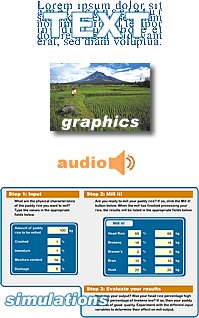|
Writing for the Web is different than writing for paper! |
|
79% of users scan the page instead of reading word-for-word. |
| Text should be set into a narrow column (~325 pixels wide) rather than allowed to stretch across the entire webpage. Narrow columns are more easily read from a computer screen than long lines of text. |
| Reading from a computer screen is 25% slower than from paper |
| Web content should have 50% of the word count of its paper equivalent. |
|
Given the conditions stated above, it is critical to write your content in a way that is easy to read and digestible. This means:
|

|
A picture is worth a thousand words! |
|
Graphics, in the form of photos, charts, diagrams, and artwork, can be an effective way to describe concepts and add visual interest to your lessons. However, the overuse of graphical elements can be distracting and reduce the speed of which your pages load. |
|
Personalize your lessons with audio. |
|
By no means should you use audio to read the entirety of a lesson to a learner. Nevertheless, audio can assist with humanizing the content by having a voice either welcome the learner to the course or give an introduction to a lesson. Audio can also be effective for providing auditory interest to simulations. Users, however, must have a soundcard and speakers installed in their computers to benefit from audio. |
|
Simulations make the content real. |
|
Simulations are time consuming to build but provide a powerful means for bringing content to life. Click here to experiment with a simulation built for the IRRI Knowledge Bank course, Grain Quality. |